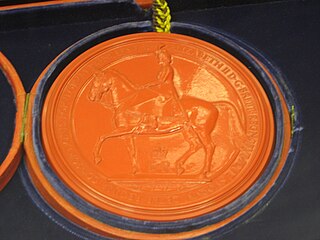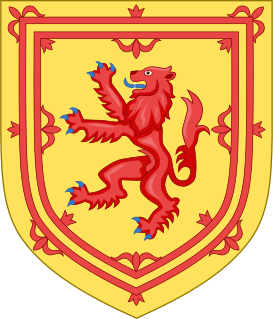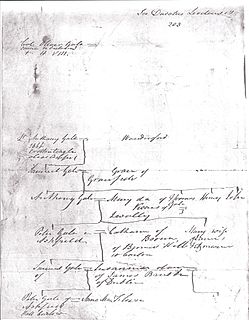
Somerset County is the southernmost county in the U.S. state of Maryland. As of the 2010 census, the population was 26,470. making it the second-least populous county in Maryland. The county seat is Princess Anne.
Queen Anne often refers to:

The flag of England is derived from Saint George's Cross. The association of the red cross as an emblem of England can be traced back to the Late Middle Ages, and it was increasingly used alongside the Royal Banner in the wake of the English Reformation, especially as a maritime flag. It was used as a component in the design of the Union Jack in 1606.

The Red Ensign or "Red Duster" is the civil ensign of the United Kingdom of Great Britain and Northern Ireland. It is one of the British ensigns, and it is used either plain or defaced with a badge or other emblem, mostly in the right half.

The royal coat of arms of the United Kingdom, or the royal arms for short, is the official coat of arms of the British monarch, currently Queen Elizabeth II. These arms are used by the Queen in her official capacity as monarch of the United Kingdom. Variants of the royal arms are used by other members of the British royal family, by the British Government in connection with the administration and government of the country, and some courts and legislatures in a number of Commonwealth realms. In Scotland, there exists a separate version of the royal arms, a variant of which is used by the Scotland Office and the Judiciary. The arms in banner form serve as basis for the monarch's official flag, the Royal Standard.

Baron Baltimore, of Baltimore, County Longford, was a title in the Peerage of Ireland. It was created in 1625 and ended in 1771, upon the death of its sixth-generation male heir, aged 40. Holders of the title were usually known as Lord Baltimore for short.

The royal arms of England are the arms first adopted in a fixed form at the start of the age of heraldry as personal arms by the Plantagenet kings who ruled England from 1154. In the popular mind they have come to symbolise the nation of England, although according to heraldic usage nations do not bear arms, only persons and corporations do. The blazon of the arms of Plantagenet is: Gules, three lions passant guardant in pale or armed and langued azure, signifying three identical gold lions with blue tongues and claws, walking past but facing the observer, arranged in a column on a red background. Although the tincture azure of tongue and claws is not cited in many blazons, they are historically a distinguishing feature of the arms of England. This coat, designed in the High Middle Ages, has been variously combined with those of the Kings of France, Scotland, a symbol of Ireland, the House of Nassau and the Kingdom of Hanover, according to dynastic and other political changes occurring in England, but has not altered since it took a fixed form in the reign of Richard I of England (1189–1199), the second Plantagenet king.

The Kingdom of England was a sovereign state on the island of Great Britain from 927, when it emerged from various Anglo-Saxon kingdoms, until 1707, when it united with Scotland to form the Kingdom of Great Britain.

The flag of the State of Maryland is the 17th-century heraldic banner of arms of Cecil, 2nd Baron Baltimore. It consists of the escutcheon of his father George, 1st Baron Baltimore (1579–1632), with the charges and fields from his coat of arms quartered with those of his grandmother, heiress of the Crossland family in the Kingdom of England. The flag was officially adopted by the General Assembly of Maryland in 1904.

The Great Seal of the Realm or Great Seal of the United Kingdom is a seal that is used to symbolise the Sovereign's approval of state documents.

The Eastern Shore of Maryland is a part of the U.S. state of Maryland that lies mostly on the east side of the Chesapeake Bay and consists of nine counties, seven of which have Chesapeake Bay coastlines. The region also contains Maryland's only coast on the Atlantic Ocean.

The Great Seal of the State of Maryland is the official government emblem of the U.S. state of Maryland. Its official service is to authenticate acts by the General Assembly of Maryland, but it is also used for display purposes at most state buildings. Although the state seal has been changed in design several times throughout history, the current model represents the reverse side of the original seal.

The coat of arms of Ireland is blazoned as Azure a harp Or, stringed Argent. These arms have long been Ireland's heraldic emblem. References to them as being the arms of the king of Ireland can be found as early as the 13th century. These arms were adopted by Henry VIII of England when he ended the period of Lordship of Ireland and declared Ireland to be a kingdom again in 1541. When the crowns of England, Scotland and Ireland were united in 1603, they were integrated into the unified royal coat of arms of kingdoms of England, Scotland and Ireland. The harp was adopted as the emblem of the Irish Free State when it separated from the United Kingdom in 1922. They were registered as the arms of Ireland with the Chief Herald of Ireland on 9 November 1945.

The royal arms of Scotland is the official coat of arms of the King of Scots first adopted in the 12th century. With the Union of the Crowns in 1603, James VI inherited the thrones of England and Ireland and thus his arms in Scotland were now quartered with the arms of England with an additional quarter for Ireland also added. Though the kingdoms of England and Scotland would share the same monarch, the distinction in heraldry used in both kingdoms was maintained. When the kingdoms of Scotland and England were united under the Acts of Union 1707 to form the Kingdom of Great Britain, no single arms were created, thereby maintaining the convention that the royal arms used in Scotland would continue to differ from those used elsewhere.

The Royal Banner of the Royal Arms of Scotland, also known as the Royal Banner of Scotland, or more commonly the Lion Rampant of Scotland, and historically as the Royal Standard of Scotland, or Banner of the King of Scots, is the Royal Banner of Scotland, and historically, the Royal Standard of the Kingdom of Scotland. Used historically by the Scottish monarchs, the banner differs from Scotland's national flag, the Saltire, in that its correct use is restricted by an Act of the Parliament of Scotland to only a few Great Officers of State who officially represent the Monarchy in Scotland. It is also used in an official capacity at royal residences in Scotland when the Head of State is not present.

The Treaty of Union is the name usually now given to the agreement which led to the creation of the new state of Great Britain, stating that England and Scotland were to be "United into One Kingdom by the Name of Great Britain", At the time it was more often referred to as the Articles of Union.

English heraldry is the form of coats of arms and other heraldic bearings and insignia used in England. It lies within the so-called Gallo-British tradition. Coats of arms in England are regulated and granted to individuals by the English kings of arms of the College of Arms. An individual's arms may also be borne ‘by courtesy' by members of the holder's nuclear family, subject to a system of cadency marks, to differentiate those displays from the arms of the original holder. The English heraldic style is exemplified in the arms of British royalty, and is reflected in the civic arms of cities and towns, as well as the noble arms of individuals in England. Royal orders in England, such as the Order of the Garter, also maintain notable heraldic bearings.

The Ashfield Gales consisted of six generations of a Gale family who owned the Ashfield estate in Killabban Parish, Queens County, Ireland from the mid-17th Century until 1851.

The current flag of Prince George's County, Maryland, was adopted in 1963, replacing one that had been in use since 1696. It is a 3 parts tall by 5 parts wide white field with a red St. George's cross atop it, with the seal of Prince George's County in the canton. Though official regulation states that the flag use the former county seal that was used from 1958 to 1971, in practice most flags that are manufactured and used by the county government itself use the current county seal, which was introduced in 1971.

The Flag of Somerset County, Maryland, United States, consists of a flag of Great Britain with the head of a Native American in the center. The flag was adopted in 1694 after the county received a Royal Warrant from King William III of England to use the Union Jack as its flag. That flag was later adopted by the Kingdom of Great Britain in 1707.

















